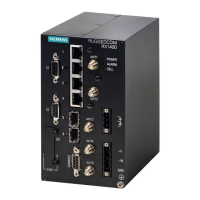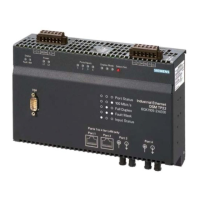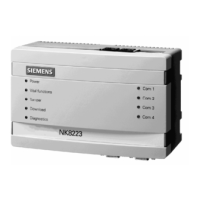RUGGEDCOM ROX II
CLI User Guide
Chapter 13
Unicast and Multicast Routing
OSPF Concepts 521
• Section13.9.9, “Managing Routing Interfaces”
• Section13.9.10, “Managing Message Digest Keys”
Section13.9.1
OSPF Concepts
When an OSPF configured router starts operating, it issues a hello packet. Routers having the same OSPF Area,
hello-interval and dead-interval timers will communicate with each other and are said to be neighbors.
After discovering its neighbors, a router will exchange Link State Advertisements in order to determine the
network topology.
Every 30 minutes (by default), the entire topology of the network must be sent to all routers in an area.
If the link speeds are too low, the links are too busy or there are too many routes, some routes may fail to get re-
announced and will be aged out.
Splitting the network into smaller areas to reduce the number of routes within an area or reducing the number of
routes to be advertised may help to avoid this problem.
In shared access networks (i.e. routers connected by switches or hubs) a designated router and a backup
designated are elected to receive route changes from subnets in the area. Once a designated router is picked, all
routing state changes are sent to the designated router, which then sends the resulting changes to all the routers.
The election is decided based on the priority assigned to the interface of each router. The highest priority wins. If
the priority is tied, the highest router-id wins.
Section13.9.2
Configuring OSPF
To configure dynamic routing using the Open Shortest Path First (OSPF) daemon, do the following:
1. Make sure the CLI is in Configuration mode.
2. Navigate to routing» ospf and configure the following parameter(s) as required:
Parameter Description
enabled Enables the OSPF dynamic routing protocol.
abr-type { abr-type } Synopsis: { cisco, ibm, shortcut, standard }
Default: cisco
The OSPF ABR type.
auto-cost-reference-bandwidth { auto-cost-
reference-bandwidth }
Synopsis: A 32-bit unsigned integer between 1 and 4294967
Default: 100
Calculates the OSPF interface cost according to bandwidth [1-4294967 Mbps]
compatible-rfc1583 Enables the compatibility with the obsolete RFC1583 OSPF (the current is RFC2178)
default-information-originate Advertises the default route.
default-metric { default-metric } Synopsis: A 32-bit unsigned integer between 0 and 16777214
The default metric of redistribute routes.
distance { distance } Synopsis: A 32-bit unsigned integer between 1 and 255
The administrative distance.
